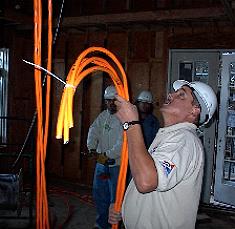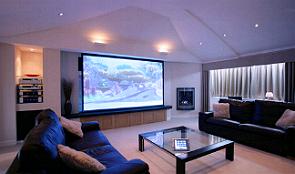The market for so-called 'smart homes' - domestic houses that use intelligent and automated systems to control household appliances and devices - has been slow to take off in the UK, though it is more common in mainland Europe. Voltimum UK managing editor James Hunt introduces this VoltiBULLETIN by looking at the reasons why, and what smart home technologies can do, especially in the light of requirements to make all new UK housing stock carbon neutral by 2016:

Such digital devices and systems need control - and being digital, this is generally quite easy to achieve. Greater flexibility, reliability and safety are also required. Such requirements, together with the need for minimum planning and installation cost, are not achieved using conventional electrical installation techniques. A good commercial/industrial example is Schneider Electric's Transparent Building Integrated System (T-BIS). This can look after lighting control, security, air conditioning and heating and ventilation, as well as electrical distribution.
However, this is also where 'smart home' technologies come into the equation. There are three basic reasons for the 'smart home'. One is to improve personal comfort, such as setting the right lights for mood without getting up, or adjusting the temperature. The second is to save energy, while the third is to improve safety and security. Systems commonly control, monitor and optimise building services such as heating, ventilation, motorised shutters or curtains, lighting and alarm systems as well as domestic appliances, hi-fi and home cinema, but can also interact with smoke and burglar alarms.
The realities of owning a 'smart home' are, if not commonplace yet in the UK, even so closer than most people realise, and some people have been beginning to spend thousands on home entertainment systems complete with surround sound. It is a natural move to get the lighting right for the media concerned. Indeed, as demand and improving technologies bring component and installation costs lower, smart home technologies will be increasingly taken up by the average homeowner - and, indeed, this was slowly accelerating, at least until the current economic difficulties took hold.
Modern 'smart home' systems are not just for large and expensive homes. In its early days, 'smart home' technology had many of its first applications in mainland Europe, and by far the largest number of applications were in new and more expensive homes. However, smaller homes can benefit too, with - for example - control of PIRs for fire and security. These devices often have 'intelligence' already built-in. Indeed, it is claimed that some basic intelligent home control systems can sometimes be obtained for the price of double glazing - typically as little as £2000.
To take one recent example, a typical four bed-roomed detached house has had just such a system installed to offer flexible switching and control for lighting, heating and shutters. Via an input relay device, it also incorporates other manufacturers' control products. A normal, competent electrical installer has carried out all work. This example shows just how important it is for electrical contractors to keep an eye open for the significant opportunities presented, now that homeowners are becoming more aware of the opportunities, and as more devices become available at reasonable prices.
Nearer the top end of the market, some companies solved convenience problems where the clients had remote buildings. More recently, some suppliers have moved into scene setting and mood controls. These systems can be readily linked to home entertainment systems - either using one of the established audio/visual protocols (e.g. DMX512) or by using a multi-function infrared 'commander'.
'Smart home' systems can be built into new homes (in which case it is important to be involved from an early stage), or retrofitted into older buildings. House builder's customers can now specify an 'smart' home, with control options for a cost typically less than 1% of the sale value, using fieldbus-based control systems typically having a backbone comprising a single twisted pair cable. Once installed, any amount of control can usually be added without any further re-cabling. Control scenarios are also easily changed or extended without complicated and messy refurbishment work. Any control combination is possible, the only real constraint being the cost of commissioning and programming.
A convergence:
The equipment and technologies involved are converging, blurring the boundaries between hi-fi systems, TVs and PCs so that linkages - such as Blu-ray (the optical disc storage medium for high-definition video and data storage) - are forming naturally. Add in Bluetooth (the wireless protocol for exchanging data over short distances from fixed and mobile devices, connecting several devices and overcoming synchronisation problems), plus similar initiatives, and the possibilities of your washing machine talking to your mobile are very real. Such wireless technologies aim to revolutionise the personal connectivity market by providing freedom from wired connections and enabling links between portable computers, mobiles, portable hand-held devices, and connectivity to the Internet. Systems such as Bluetooth work because they have been developed as cross-industry solutions that combine engineering innovation with an understanding of both business and consumer expectations.
Smart meters:
So-called 'smart meters', which are likely to be rolled out in large numbers over the next decade, will play a significant role in making electric storage heating and hot water a sustainable energy success story. Smart meters - which are electricity/gas meters with in-built intelligence - provide innovative displays in homes, and are crucial tools in providing better, more informative billing for homeowners. The latter can then better see the great potential to reduce their energy bills.
Note that such smart meters are designed for application in all homes. In a smart home environment, however, the functionality of these meters is such that they can switch the load away from appliances that do not need continuous supply. These include washing machines, tumble driers, fridge freezers, electric storage heating and hot water products. Such smart meter application allows homeowners' appliances to intelligently manage the load - the pay off being the provision of a special tariff from the energy supplier, as they should reward load management through their customers' meters.
Simplicity is crucial:
The development of human machine interfaces (HMI) for smart homes has been a neglected area. Development has tended to concentrate on the underlying technology and the applications. There will always be a few 'techies' but most homeowners will simply want to know what the system will do for them in the easiest possible way. For this reason, the user interface could be critical to success for the full introduction of this technology. The challenge of integrating many applications within a smart house, creating quite complex systems with sometimes hundreds of user controllable parameters is key. Many people are still unable to confidently programme their DVD recorders (although this is changing with the latest DVD recorders that are now much easier to use). 'Smart home' controls must similarly be simple to use.
How it works:
The technologies use a range of techniques to carry out energy management and building control tasks. Some simple analogue systems, such as timer-controlled water heaters and thermostatic radiator valves, have been around for years; others are more complex and can enable significant energy savings and the control of fire safety and security systems.
Typically, a central control unit may run the entire system, based on information supplied by sensors (such as pre-set instructions for some of the devices), and by controls from homeowners. Commands can be sent through a two-wire fieldbus system, power lines, telephone lines or fibre-optic cables - or, increasingly, wirelessly. Essentially, the fieldbus system in homes and offices acts as a backbone for the system automatic controller and devices.
Sensors send signals over a transmission medium to the devices (such as actuators), which, in the temperature example, might be used to turn on a radiator, or control an entire air-conditioning system. New functions can be added at any time. Sensors and actuators are programmed and linked as the requirements of the system dictates, so that - for example - home owners can alter home equipment settings according to their wishes via a keypad, telephone or PC.
Some developments have been based on distributed-intelligence microprocessors. Here, 'intelligent' peripheral units manage a variety of local tasks and functions, while the central unit acts as a supervisor.
Today, the dominant 'backbone' for such systems is Ethernet-based. For example, Echelon's 'Lonworks' building automation system uses the Ethernet as its backbone, as does the Electrical Installation Bus (EIB). In such a system, the backbone remains a constant, while the application layers (such as an EIB device - a fan, for example), vary. System transmission media are typically 24V bus cable, EIB radio frequency, via infrared, the Ethernet and wireless technologies.
There is also KNX, which has become the new standard in building technology. See later in this VoltiBULLETIN for more information on KNX and EIB.
The future:
For the future, smart homes, and many other commercial buildings, are likely to have features such as demand-control strategies for ventilation, lighting, heating and cooling; optimal control of heating and cooling processes; the use of programming to provide for a more flexible representation of users' needs; and using expert systems. The latter may be based on neural networks for 'smart' management systems. Ethernet as a backbone is likely to continue to increase its dominance. Wireless technologies will become more common
Development will keep in touch with emerging communications technology to ensure that integration with other systems is straightforward.
Most importantly, smart home technology development is being given impetus by the need to reduce carbon emissions from UK homes. Smart home technologies have the potential to save large amounts of energy, even though the best short-term solution is widespread and effective home insulation.
For more on smart homes and intelligent buildings:
Lighting controls and DALI - Away from the purely domestic, building management systems (BMS) can incorporate special lighting control networks, as well as for control of heating and air-conditioning etc. An example is the major lighting-specific control protocol, Digital Addressable Lighting Interface (DALI).
www.voltimum.co.uk/news/11631/consult.experts_hottopics.smarthomes/Lighting-controls-and-DALI.html
Smart homes - smart thinking - The development of smart technologies, and the application of them in so-called 'smart homes' is not new. However, following the announcement that all new dwellings in England must be carbon neutral by 2016, the topic has gained far higher importance. Legrand's Alastair Ramsay reports on the impact that smart technology will have on wiring devices and related installation work.
www.voltimum.co.uk/news/11621/consult.experts_hottopics.smarthomes/Smart-homes---smart-thinking.html
Building systems get smart - With the rising costs of utilities and increasingly stringent Government regulations on energy, facilities managers need to overcome increasing challenges to ensure their buildings are managed efficiently and cost effectively. Schneider Electric's Building Systems and Solutions division shows how an intelligent building system can help achieve these goals.
www.voltimum.co.uk/news/11620/consult.experts_hottopics.smarthomes/Building-systems-get-smart.html
The smarter choice for efficient energy management - Smart controls do not just benefit 'smart homes' - they also offer industrial and commercial facilities an effective way to save energy with minimum supervision. Gareth Rowlands, Product Manager for EIB, ABB low voltage products, explains how intelligent building controls can be used to reduce the energy consumption of office and factory buildings and plants.
KNX - making technology work together and saving energy - KNX UK is an association of UK manufacturers, integrators, training establishments and other interested parties. The Association promotes the KNX standard for building control and automation within the UK together with all the products and services offered by members. As such, KNX has relevance to 'smart' buildings.
